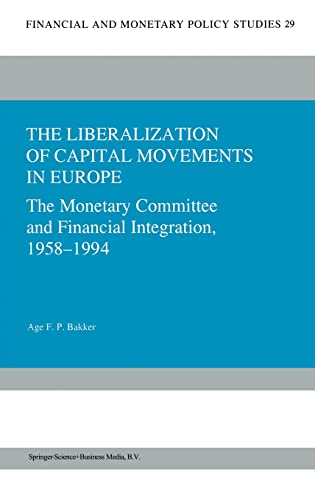The Liberalization of Capital Movements in Europe: The Monetary Committee and Financial Integration 1958-1994: v. 29 (Financial and Monetary Policy Studies) - Hardcover

Inhaltsangabe
1. Introduction. 2. Capital restrictions: classification and general observations. 3. The Treaty of Rome and capital movements. 4. The role of the Monetary Committee. 5. The 1960s: lost momentum. 6. The 1970s: lost control. 7. The 1980s: liberalization and deregulation. 8. Towards the full liberalization of capital movements. 9. Towards Economic and Monetary Union. 10. Conclusion. Chronology of major measures with respect to the regime of capital movements in the member states of the European Community. Chronology of general events in Europe. Annexes. Literature. Index A: subjects. Index B: persons.
Die Inhaltsangabe kann sich auf eine andere Ausgabe dieses Titels beziehen.
Reseña del editor
This book provides a comprehensive overview of the process of capital liberalization in Europe from the time of the writing of the Treaty of Rome in the 1950s to the complete abolition of restrictions in the latter half of the 1980s and early 1990s in the run up to Economic and Monetary Union. The process is described mainly from an institutional angle, with special reference to the far-reaching discussions in the Monetary Committee and the role of the European Commission. Related topics such as monetary cooperation, the working of the European Monetary System, taxation and supervision issues are also dealt with. The book highlights the motives which countries held with respect to maintaining or abolishing restrictions. Their eventual abolition had important consequences for the financial structure in member states and for the transition to the use of indirect instruments of monetary policy by the national central banks. The book will be of outstanding interest for anyone who is professionally involved in European integration issues and in monetary and financial policy.
Reseña del editor
This work offers a review of liberalization of capital movements in Europe, from the time that the Treaty of Rome was written in the 1950s to the complete abolition of restrictions in the latter half of the 1980s and early 1990s in the run up to Economic and Monetary Union. The process is described mainly from an institutional angle, with special reference to the far-reaching discussions in the Monetary Committee and the role of the European Commission. Related topics are also dealt with, such as monetary co-operation, the working of the European Monetary System, taxation and supervision issues. The book highlights the motives which drove countries in their desire to maintain or abolish restrictions. The eventual abolition of restrictions had important consequences for the financial structure in member states and for the transition to the use of indirect instruments of monetary policy by the national central banks. The work should be of interest to anyone who is professionally involved in European integration issues, and in monetary and financial policy.
„Über diesen Titel“ kann sich auf eine andere Ausgabe dieses Titels beziehen.
Weitere beliebte Ausgaben desselben Titels
Suchergebnisse für The Liberalization of Capital Movements in Europe:...
The Liberalization of Capital Movements in Europe: The Monetary Committee and Financial Integration, 1958-1994 (Financial and Monetary Policy Studies)
Anbieter: Wonder Book, Frederick, MD, USA
Zustand: Very Good. Very Good condition. Volume 29. A copy that may have a few cosmetic defects. May also contain light spine creasing or a few markings such as an owner's name, short gifter's inscription or light stamp. Artikel-Nr. A11A-03450
The Liberalization of Capital Movements in Europe: The Monetary Committee and Financial Integration 1958-1994
Anbieter: Revaluation Books, Exeter, Vereinigtes Königreich
Hardcover. Zustand: Brand New. 333 pages. 10.00x6.75x1.25 inches. In Stock. Artikel-Nr. x-0792335910
Neu kaufen
Anzahl: 2 verfügbar
The Liberalization of Capital Movements in Europe : The Monetary Committee and Financial Integration, 1958-1994
Anbieter: AHA-BUCH GmbH, Einbeck, Deutschland
Buch. Zustand: Neu. Druck auf Anfrage Neuware - Printed after ordering - This book provides a comprehensive overview of the process of capital liberalization in Europe from the time of the writing of the Treaty of Rome in the 1950s to the complete abolition of restrictions in the latter half of the 1980s and early 1990s in the run up to Economic and Monetary Union. The process is described mainly from an institutional angle, with special reference to the far-reaching discussions in the Monetary Committee and the role of the European Commission. Related topics such as monetary cooperation, the working of the European Monetary System, taxation and supervision issues are also dealt with. The book highlights the motives which countries held with respect to maintaining or abolishing restrictions. Their eventual abolition had important consequences for the financial structure in member states and for the transition to the use of indirect instruments of monetary policy by the national central banks. The book will be of outstanding interest for anyone who is professionally involved in European integration issues and in monetary and financial policy. Artikel-Nr. 9780792335917
Neu kaufen
Anzahl: 2 verfügbar
The Liberalization of Capital Movements in Europe
Anbieter: moluna, Greven, Deutschland
Gebunden. Zustand: New. This book provides a comprehensive overview of the process of capital liberalization in Europe from the time of the writing of the Treaty of Rome in the 1950s to the complete abolition of restrictions in the latter half of the 1980s and early 1990s in the r. Artikel-Nr. 898696772
Neu kaufen
Anzahl: Mehr als 20 verfügbar

